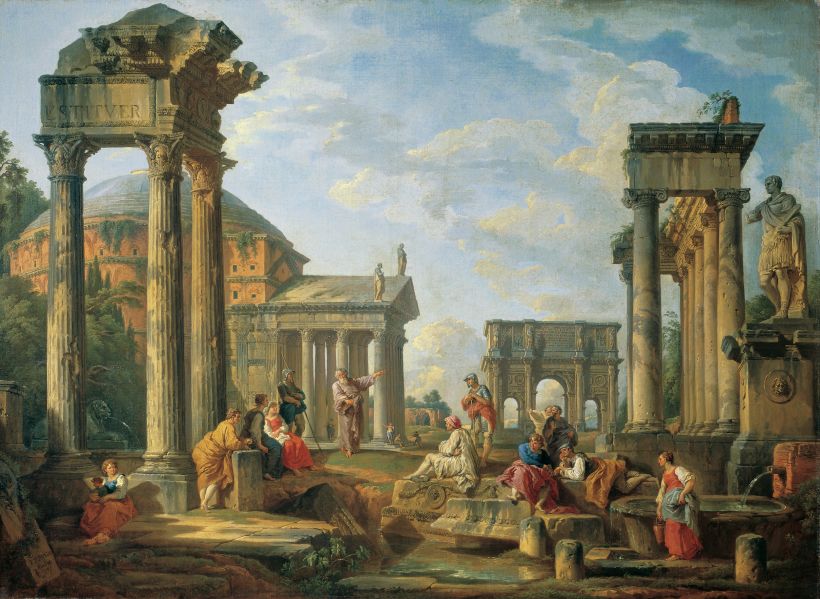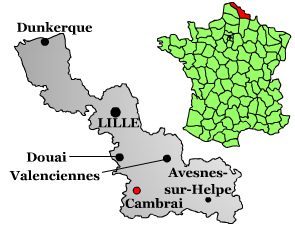|
Baaigem
Baaigem is one of the six villages belonging to the municipality Gavere. It is located on the edge of the Flemish Ardennes, the hilly southern part of the province of East Flanders, Belgium, and used to be an independent municipality till the end of 1976. Baaigem is 3.79 square kilometer large, and had 565 inhabitants on 31 December 2005. Its population is the smallest among the six villages of Gavere. Places of interest First record about the Saint-Bavo Church of Baaigem dates back to 1096. In that year, the Bishop of Cambrai (Kamerijk) allocated the patronage of the church to the Saint-Peters Abbey of Dikkelvenne, which moved then to the City of Geraardsbergen to become the Saint-Adrian Abbey. In 1147 the patronage was transferred to the Abbey of Anchin in northern France. The original church building had one nave and was made out of Tournai limestone. In the latter half of the 13th century, the nave was enlarged by 6 meters and at the west side of the church a new front a ... [...More Info...] [...Related Items...] OR: [Wikipedia] [Google] [Baidu] |
Gavere
Gavere () is a municipality located in the Belgian province of East Flanders. The municipality comprises the towns of , Baaigem, , Gavere, and . In 2021, Gavere had a total population of 13,007. The total area is 31.35 km². Sports The Superprestige Gavere is a November cyclo-cross race held in Gavere, Belgium, which is part of the Superprestige. Military The Air Traffic Control center of the Belgian Air Component is based in Semmerzake. See also * Lamoraal van Egmont Lamoral, Count of Egmont, Prince of Gavere (18 November 1522 – 5 June 1568) was a general and statesman in the Spanish Netherlands just before the start of the Eighty Years' War, whose execution helped spark the national uprising that eventual ..., Prince of Gavere References External links * Official website Municipalities of East Flanders Populated places in East Flanders {{EastFlanders-geo-stub ... [...More Info...] [...Related Items...] OR: [Wikipedia] [Google] [Baidu] |
Village
A village is a clustered human settlement or community, larger than a hamlet but smaller than a town (although the word is often used to describe both hamlets and smaller towns), with a population typically ranging from a few hundred to a few thousand. Though villages are often located in rural areas, the term urban village is also applied to certain urban neighborhoods. Villages are normally permanent, with fixed dwellings; however, transient villages can occur. Further, the dwellings of a village are fairly close to one another, not scattered broadly over the landscape, as a dispersed settlement. In the past, villages were a usual form of community for societies that practice subsistence agriculture, and also for some non-agricultural societies. In Great Britain, a hamlet earned the right to be called a village when it built a church. [...More Info...] [...Related Items...] OR: [Wikipedia] [Google] [Baidu] |
Balegem
Oosterzele () is a municipality located in the Flemish province of East Flanders, in Belgium. The municipality comprises the towns of , , , , Oosterzele proper and . In 2021, Oosterzele had a total population of 13,740. The total area is 43.12 km². Its twin town is Oberkirch in Germany. Geography Oosterzele is subdivided into 6 sub-municipalities: Famous inhabitants * Els De Temmerman, journalist, activist *Johan Van Hecke, politician * Gustaaf Joos, Roman Catholic cardinal * Frans Van De Velde (1909-2002), missionary *Gerard Vekeman (1933), poet * Walter Muls (1961), politician * Tom De Sutter (1985), football player *Johan Taeldeman Johan * Johan (given name) * ''Johan'' (film), a 1921 Swedish film directed by Mauritz Stiller * Johan (band), a Dutch pop-group ** ''Johan'' (album), a 1996 album by the group * Johan Peninsula, Ellesmere Island, Nunavut, Canada * Jo-Han, a manu ..., linguist, dialectologist, professor-emeritus UGent References External links * Of ... [...More Info...] [...Related Items...] OR: [Wikipedia] [Google] [Baidu] |
Cultural Heritage
Cultural heritage is the heritage of tangible and intangible heritage assets of a group or society that is inherited from past generations. Not all heritages of past generations are "heritage"; rather, heritage is a product of selection by society. Cultural heritage includes cultural property, tangible culture (such as buildings, monuments, landscapes, books, works of art, and artifacts), intangible heritage, intangible culture (such as folklore, traditions, language, and knowledge), and natural heritage (including culturally significant landscapes, and biodiversity).Ann Marie Sullivan, Cultural Heritage & New Media: A Future for the Past, 15 J. MARSHALL REV. INTELL. PROP. L. 604 (2016) https://repository.jmls.edu/cgi/viewcontent.cgi?article=1392&context=ripl The term is often used in connection with issues relating to the protection of Indigenous intellectual property. The deliberate act of keeping cultural heritage from the present for the future is known as Conservation (cul ... [...More Info...] [...Related Items...] OR: [Wikipedia] [Google] [Baidu] |
Government Of Flanders
The Flemish Government ( nl, Vlaamse regering ) is the executive branch of the Flemish Community and the Flemish Region of Belgium. It consists of a government cabinet, headed by the Minister-President and accountable to the Flemish Parliament, and the public administration (civil service) divided into 13 policy areas, each with an executive department and multiple agencies. The Flemish Government cabinet consists of up to a maximum of eleven ministers, chosen by the Flemish Parliament. At least one minister must come from Brussels. The ministers are drawn from the political parties which, in practice, form the governing coalition. The Government is chaired by the Flemish Minister-President. Ministers head executive departments of the government administration. Ministers must defend their policies and performance in person before the Flemish Parliament. The Flemish Government must receive and keep the confidence of the Flemish Parliament. Until 1993 the Flemish Government was call ... [...More Info...] [...Related Items...] OR: [Wikipedia] [Google] [Baidu] |
Cambrai
Cambrai (, ; pcd, Kimbré; nl, Kamerijk), formerly Cambray and historically in English Camerick or Camericke, is a city in the Nord department and in the Hauts-de-France region of France on the Scheldt river, which is known locally as the Escaut river. A sub-prefecture of the department, Cambrai is a town which had 32,501 inhabitants in 2018. It is in the heart of the urban unit of Cambrai with 46,772 inhabitants. Its functional area, a more extensive range, included 94,576 inhabitants in 2018.Comparateur de territoire: Aire d'attraction des villes 2020 de Cambrai (108), Unité urbaine 2020 de Cambrai (59403), Commune de Cambrai (59122) INSEE With |
Count Of Flanders
The count of Flanders was the ruler or sub-ruler of the county of Flanders, beginning in the 9th century. Later, the title would be held for a time, by the rulers of the Holy Roman Empire and Spain. During the French Revolution, in 1790, the county of Flanders was annexed to France and ceased to exist. In the 19th century, the title was appropriated by Belgium and granted twice to younger sons of Belgian kings. The most recent holder died in 1983. In 862 Baldwin I was appointed as the first Margrave of Flanders by King Charles II. It was a military appointment, responsible for repelling the Viking raids from the coast of Francia. The title of margrave (or marquis) evolved into that of count. Arnulf I was the first to name himself as count, by the Grace of God. The title of margrave largely fell out of use by the 12th century. Since then, the rulers of Flanders have only been referred to as counts. The counts of Flanders enlarged their estate through a series of diploma ... [...More Info...] [...Related Items...] OR: [Wikipedia] [Google] [Baidu] |
Cultural Heritage
Cultural heritage is the heritage of tangible and intangible heritage assets of a group or society that is inherited from past generations. Not all heritages of past generations are "heritage"; rather, heritage is a product of selection by society. Cultural heritage includes cultural property, tangible culture (such as buildings, monuments, landscapes, books, works of art, and artifacts), intangible heritage, intangible culture (such as folklore, traditions, language, and knowledge), and natural heritage (including culturally significant landscapes, and biodiversity).Ann Marie Sullivan, Cultural Heritage & New Media: A Future for the Past, 15 J. MARSHALL REV. INTELL. PROP. L. 604 (2016) https://repository.jmls.edu/cgi/viewcontent.cgi?article=1392&context=ripl The term is often used in connection with issues relating to the protection of Indigenous intellectual property. The deliberate act of keeping cultural heritage from the present for the future is known as Conservation (cul ... [...More Info...] [...Related Items...] OR: [Wikipedia] [Google] [Baidu] |
Gothic Revival Architecture
Gothic Revival (also referred to as Victorian Gothic, neo-Gothic, or Gothick) is an architectural movement that began in the late 1740s in England. The movement gained momentum and expanded in the first half of the 19th century, as increasingly serious and learned admirers of the neo-Gothic styles sought to revive medieval Gothic architecture, intending to complement or even supersede the neoclassical styles prevalent at the time. Gothic Revival draws upon features of medieval examples, including decorative patterns, finials, lancet windows, and hood moulds. By the middle of the 19th century, Gothic had become the preeminent architectural style in the Western world, only to fall out of fashion in the 1880s and early 1890s. The Gothic Revival movement's roots are intertwined with philosophical movements associated with Catholicism and a re-awakening of high church or Anglo-Catholic belief concerned by the growth of religious nonconformism. Ultimately, the " Anglo-Catholicis ... [...More Info...] [...Related Items...] OR: [Wikipedia] [Google] [Baidu] |
Dutch Revolt
The Eighty Years' War or Dutch Revolt ( nl, Nederlandse Opstand) ( c.1566/1568–1648) was an armed conflict in the Habsburg Netherlands between disparate groups of rebels and the Spanish government. The causes of the war included the Reformation, centralisation, taxation, and the rights and privileges of the nobility and cities. After the initial stages, Philip II of Spain, the sovereign of the Netherlands, deployed his armies and regained control over most of the rebel-held territories. However, widespread mutinies in the Spanish army caused a general uprising. Under the leadership of the exiled William the Silent, the Catholic- and Protestant-dominated provinces sought to establish religious peace while jointly opposing the king's regime with the Pacification of Ghent, but the general rebellion failed to sustain itself. Despite Governor of Spanish Netherlands and General for Spain, the Duke of Parma's steady military and diplomatic successes, the Union of Utr ... [...More Info...] [...Related Items...] OR: [Wikipedia] [Google] [Baidu] |
Transept
A transept (with two semitransepts) is a transverse part of any building, which lies across the main body of the building. In cruciform churches, a transept is an area set crosswise to the nave in a cruciform ("cross-shaped") building within the Romanesque and Gothic Christian church architectural traditions. Each half of a transept is known as a semitransept. Description The transept of a church separates the nave from the sanctuary, apse, choir, chevet, presbytery, or chancel. The transepts cross the nave at the crossing, which belongs equally to the main nave axis and to the transept. Upon its four piers, the crossing may support a spire (e.g., Salisbury Cathedral), a central tower (e.g., Gloucester Cathedral) or a crossing dome (e.g., St Paul's Cathedral). Since the altar is usually located at the east end of a church, a transept extends to the north and south. The north and south end walls often hold decorated windows of stained glass, such as rose wind ... [...More Info...] [...Related Items...] OR: [Wikipedia] [Google] [Baidu] |
_-_church.jpg)



.png)




.jpg)